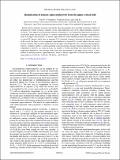Identification of nematic superconductivity from the upper critical field
Author(s)
Venderbos, Joern Willem Friedrich; Kozii, Vladyslav; Fu, Liang
DownloadPhysRevB.94.094522.pdf (347.0Kb)
PUBLISHER_POLICY
Publisher Policy
Article is made available in accordance with the publisher's policy and may be subject to US copyright law. Please refer to the publisher's site for terms of use.
Terms of use
Metadata
Show full item recordAbstract
Recent nuclear magnetic resonance and specific heat measurements have provided concurring evidence of spontaneously broken rotational symmetry in the superconducting state of the doped topological insulator Cu[subscript x]Bi[subscript 2]Se[subscript 3]. This suggests that the pairing symmetry corresponds to a two-dimensional representation of the D[subscript 3d] crystal point group, and that Cu[subscript x]Bi[subscript 2]Se[subscript 3] is a nematic superconductor. In this paper, we present a comprehensive study of the upper critical field H[subscript c2] of nematic superconductors within Ginzburg-Landau (GL) theory. Contrary to typical GL theories which have an emergent U(1) rotational symmetry obscuring the discrete symmetry of the crystal, the theory of two-component superconductors in trigonal D[subscript 3d] crystals reflects the true crystal rotation symmetry. This has direct implications for the upper critical field. First, H[subscript c2] of trigonal superconductors with D[subscript 3d] symmetry exhibits a sixfold anisotropy in the basal plane. Second, when the degeneracy of the two components is lifted by, e.g., uniaxial strain, H[subscript c2] exhibits a twofold anisotropy with characteristic angle and temperature dependence. Our thorough study shows that measurement of the upper critical field is a direct method of detecting nematic superconductivity, which is directly applicable to recently-discovered trigonal superconductors Cu[subscript xBi[subscript 2Se[subscript 3], Sr[subscript x]Bi[subscript 2]Se[subscript 3], Nb[subscript x]Bi[subscript 2]Se[subscript 3], and Tl[subscript x]Bi[subscript 2]Te[subscript 3].
Date issued
2016-09Department
Massachusetts Institute of Technology. Department of PhysicsJournal
Physical Review B
Publisher
American Physical Society
Citation
Venderbos, Jörn W. F., Vladyslav Kozii, and Liang Fu. "Identification of nematic superconductivity from the upper critical field" Physical Review B, vol. 94, 094522, September 2016, pp. 1-7.
Version: Final published version
ISSN
1098-0121
1550-235X